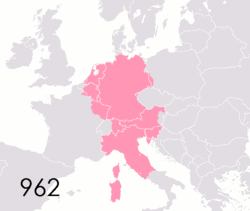The special status of these families manifested itself in the constitution of the Empire as it evolved in the 16th c. To the status of territorial ruler corresponded a seat and vote in one of the colleges of the Reichstag, the Imperial Diet. In the late 16th c., the multiplication of votes due to territorial fragmentation led to reforms. After the Diet held at Augsburg in 1582, the list of votes remained fixed, notwithstanding further territorial divisions. Furthermore, the right to vote became attached to a land, rather than to a person or family (of course, land was inheritable within families). A member of the Diet with seat and vote (individual or shared) was called a Reichsstand, or state of the Empire.
At some point (Abt 1911, 103 n2 cites various possible dates, from the turn of the 16th c. to 1653 to the 18th c. [5] ), the definition of Hochadel became congruent with being a Reichsstand (adjective: reichsständisch). The reason is that the Emperor, as "fons nobilitatium," had the power to create new princes, counts and barons of the Empire, a power which he began to use more frequently. The existing princes, counts and barons were obviously loath to see the value of their title diminished. The members of the Diet complained and, after 1582, it became the rule that such new princes and counts would not of right have a seat at the Diet. Furthermore, in 1653 the Electoral Capitulation included strict rules on the process by which the Emperor could create new states of the Empire. In particular, any new member had to possess an immediate territory of sufficient size, and had to be accepted by his peers (princes or counts).
Thus a distinction emerged between
- families that were part of the Diet in 1582: the "old princely" and "old comital" (altfürstliche, altgräfliche) families
- families who were admitted to the Diet between 1582 and 1803: the "new princely" (neufürstliche) and "new comital" (neugräfliche) families
- families or individuals who received the title of Reichsfreiherr, Reichsgraf or Reichsfürst but were not admitted to the Diet
Only the first two groups were part of the Hochadel. Those in the third group were titular counts and princes but in no way accepted as part of the Hochadel.
Thus it would seem that having seat and vote in the Reichstag would be a clear criterion for belonging to the Hochadel. But there were further complications:
- In principle, the possession of a territory was a pre-condition for admission in the Diet. However, in the second half of the 18th century a number of counts sat on the counts' benches without any such territory. They were called "personalists" because they had been admitted on a personal basis (ad personam), and some jurists did not consider them to be part of the upper nobility (e.g., Pütter 1795, 143).
- Possession of a large immediate territory was a condition for entry, but not a condition for remaining in the Diet. It happened that territories became subjected to another state of the Empire, thus losing immediate status; yet the owner remained in the Diet.
Consequently, whereas, in the 16th century, it was fairly easy to say who was in the upper nobility and who wasn't, it had become more difficult by the turn of the 19th century.
Three concepts came into play:
- immediacy (Reichsunmittelbarkeit),
- sovereignty over a territory (Landeshoheit),
- a seat and vote at the Imperial Diet (Reichsstandschaft).
The three were "usually" related, in that the sovereign of a territory was a state of the Empire, and a state of the Empire usually had sovereignty over an immediate territory; but there were exceptions both ways. Various authors emphasized one or a combination of these elements. Thus, Runde (1791) required all three; Pütter emphasized sovereignty; Gönner [6] and Leist [7] emphasized seat and vote at the Diet. Among 19th century authors, the main division was between those who required all three criteria, and those who considered Reichsstandschaft to be the sole criterion (Hohler, Klüber, Zoepf, Rehm).
Using the second, slightly broader concept, at the end of the 18th century the high nobility consisted of those families which had seat and vote at the Imperial Diet, with title of either prince or count (the last baronial family died out in 1775), numbering about 25 princely (fürstliche) and 80 comital (gräfliche) families.
